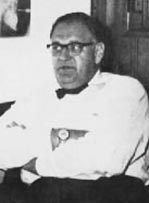One Giant Step from Flatland to Spaceland
The development of electronic devices to measure the electrical activity of the head, neck, and facial muscles; to locate the position of the mandible precisely in relation to the skull in three dimensions; and to track the opening and closing movements of the mandible is a breakthrough of potentially gigantic proportions with regard to the future of orthodontic practice.
Apart from clinical observation, study models, and the interpolation of lateral and frontal x-ray information, orthodontists have been living in Flatland up to this time. Flatland is a mythical country created by an English schoolmaster, Edwin A. Abbott, more than 100 years ago. Abbott tried to imagine what a two-dimensional world would be like, and described how incomprehensible three-dimensional concepts of Spaceland are to inhabitants of Flatland. One example of orthodontic Flatland will suffice. We measure the length of the mandible on a lateral cephalometric tracing from condylion to gnathion. Change your perspective and view that same measurement from above. What you have actually seen is a line equal to a perpendicular line from a condylio-ncondylion line to gnathion in the midline.
Whatever virtues lateral and frontal cephalograms and laminagrams may have in providing useful information on the relationship of parts of the head, there is a need to visualize and measure jaw movement in three dimensions. The mandibular kinesiograph is capable of doing this and, together with the electromyograph and TENS equipment such as the Myo-monitor, it is capable of identifying a neuromuscular rest position from which the patient can close to a neuromuscularly coordinated position of occlusion.
Orthodontists have been largely disregarding the muscle system that supports and moves the jaw, because we have not had clinically useful tools to monitor muscle activity. Yet, it seems obvious that the condition and activity of these muscles is crucial to obtaining an optimum tooth-to-tooth relationship in an optimum jaw-to-jaw relationship. With the advent of equipment that can be used in a clinical setting, the search for physiologic rest position has literally been taken out of the orthodontist's hands.
The importance of this is in enabling a diagnosis for patients with muscular imbalances caused by their malocclusion under conditions that would exist if the muscles were in a balanced condition and at their relaxed resting lengths. That gives the orthodontist the opportunity to plan treatment in the same relaxed environment that will surround the finished occlusion. The possibilities for post-treatment stability--for reducing the orthodontist's anxiety in retention, and for reducing the length of retention--and for posttreatment patient comfort make this concept worth investigating.
While it has been shown that muscles do grow in length and that their attachments do migrate as bones grow, there does not appear to be such a universal happy result of these activities as far as orthodontic patients are concerned-- certainly as far as adult orthodontic patients are concerned. If malocclusions were really in a state of balance as has long been suggested, we would not find the muscle imbalances that we do in patients who have a long list of TMJ-related symptoms.
If you ask an orthodontist to show you 10 cases 10 years out of retention, he may not be able to do it. We are not in the habit of observing patients for long years post-treatment. That means we do not know what happens to them after they leave our practice, and we cannot disregard the possibility that treating malocclusions to an existing muscle imbalance may have ramifications for the patient some time after they leave our care. The medicolegal possibilities are scary enough, but the conscientious orthodontist must ask himself, "Did I do the best I could to correct the malocclusion and give each patient a fine appearance and a nice smile as they departed the practice; but did I also achieve the most stable, comfortable, and trouble-free occlusion for the foreseeable future?"
There is a suggestion in all this that orthodontics should stop looking upon patients as transients. Muscles may not stay in a relaxed state, due to psychic or other input. We may eliminate the occlusion as a source of muscle tension or as a trigger for bruxing and clenching, but other influences may prevail in time. Occlusion is also not set in concrete. Teeth may migrate and both wear and tear and dental restorations may interfere with a previously balanced, relaxed musculature. There are probably millions of people who ought to be seeing their orthodontist on a continuing basis to monitor the occlusion and the musculature.
This opens a whole new concept of the role of the orthodontist. It may contribute to achieving the right correction and reduce the length and uncertainty of retention, but it also expands the orthodontist's role beyond an excellent correction of a malocclusion, and puts the orthodontist in a position of master diagnostician and therapist for muscle-related problems of the head and neck, including but beyond the occlusion.
Credit for the development of the electronic tools and the vision of three-dimensional diagnosis and treatment belongs to Dr. Bernard Jankelson, whose contributions to the field of prosthetics and now orthodontics mark him as a giant in our profession in our time. JCO is honored to present his concepts and pleased to be instrumental in reporting another significant advance in our specialty.


